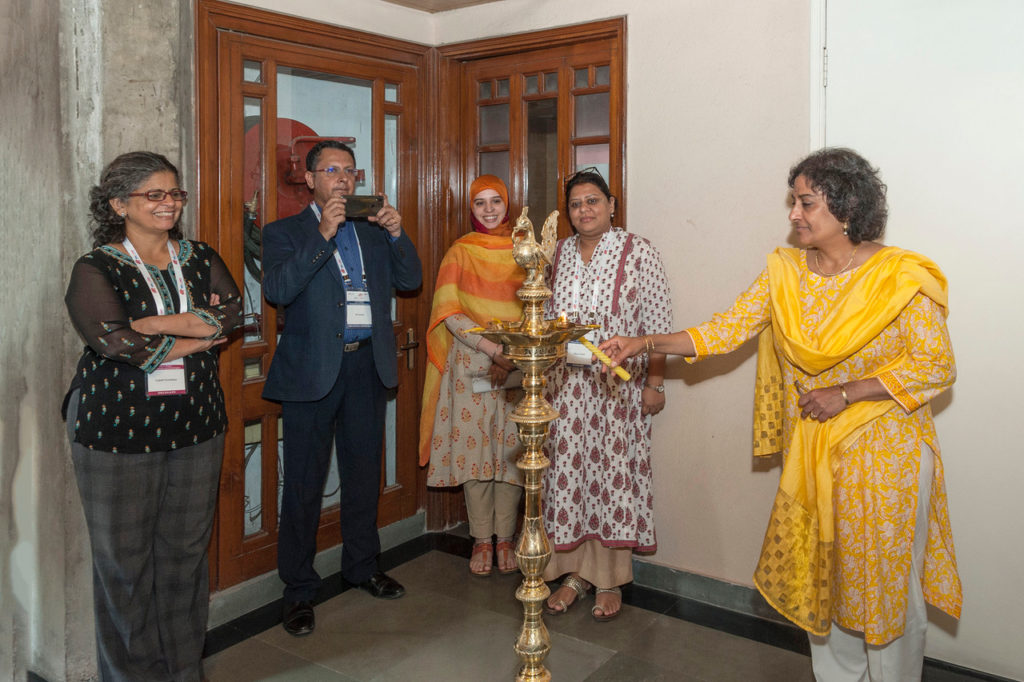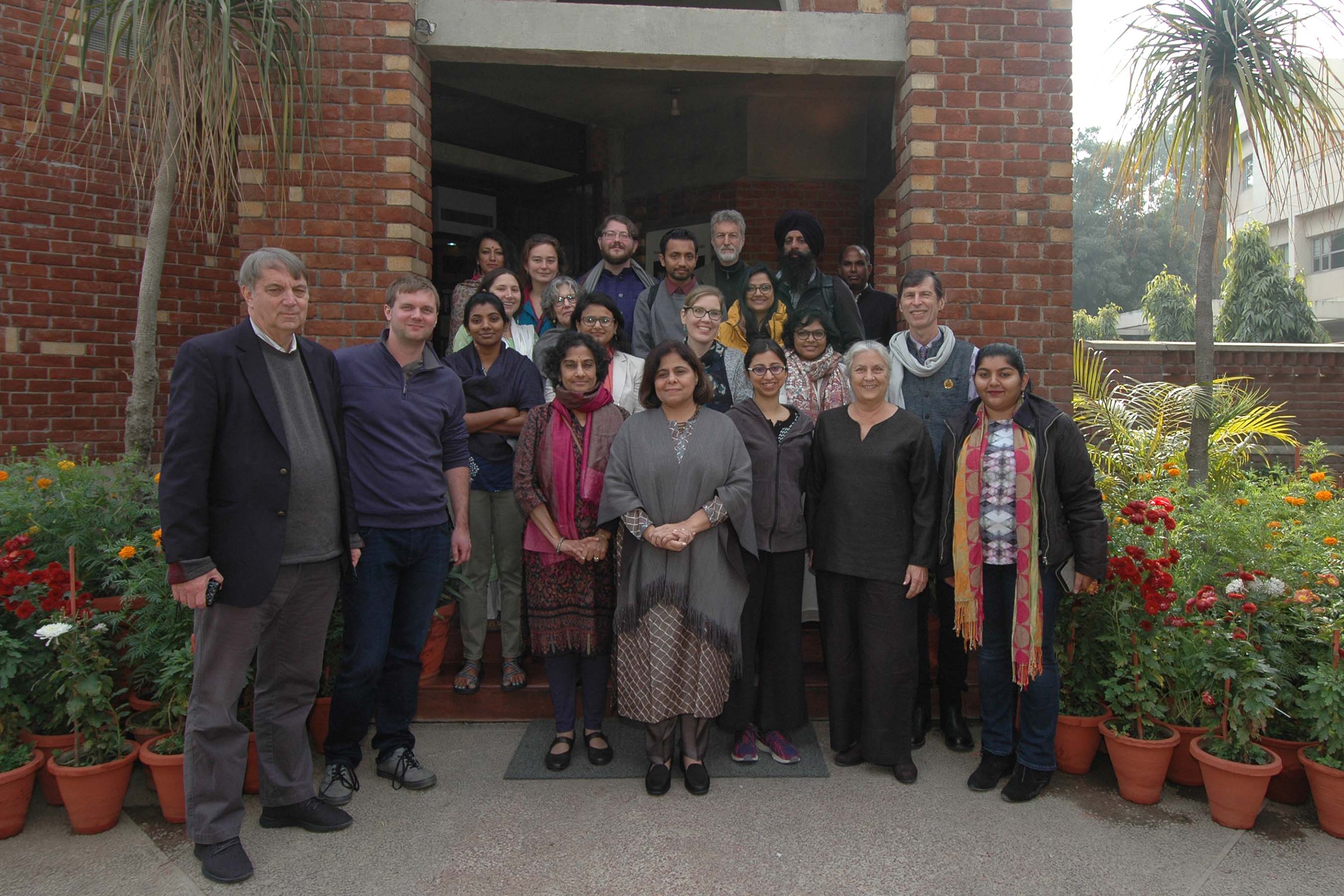
Sumathi Ramaswamy
Sumathi Ramaswamy, James B. Duke Professor of History at Duke University, recently began her term as President of AIIS. We caught up with her to talk about the Institute’s past, present, and future.
AIIS: What do you see in the future of AIIS that excites you? What are some goals for the next few years?
SR: As I observed about a year ago when the announcement regarding my Presidency was published, not least of the impressive achievements of AIIS remains the fact that it is an institution founded by academics for the advancement of academics, and governed by academics. Almost all this work is entirely voluntary, and I remain in awe of our colleagues who have over the decades—since 1961—dedicated their valuable time and effort in this manner.
Immediate gratitude is owed to Philip Lutgendorf, our former President and now Board Chair, Ralph Nicholas, who just stepped down as Board Chair (and was a former President), and Vijay Pinch, our outgoing Treasurer. Under their stewardship for the last six years, AIIS has gone from strength to strength and has also undergone some critical changes in its governing structure which has expanded its footprint across the US academy and made it more efficient in the way it functions. I am also very grateful to Siddharth Chandra who has so graciously agreed to serve as our new Treasurer and brings to the position a fantastic skill set including his experience as President of the American Institute for Indonesian Studies, so really the Institute is in good hands with two Presidents to help lead!
I am also so very impressed with our dedicated professional staff who keep AIIS going on an everyday basis, attending to both routine business but also finding creative solutions to thorny issues that inevitably arise, and also provide the sense of continuity that is so necessary for any institution to flourish. Many of the staff have served for years, and some even for decades, as I have learned over the course of my orientation meetings. This in itself is something to laud and points to the Institute as a workplace that our colleagues not just value but also enjoy.

Prof. Ramaswamy at the AIIS workshop for South Asian archivists and librarians
One of my critical goals is to ensure that AIIS remains a place which brings out the best in all those who serve it in various capacities, and also a place to which scholars can come with fresh and innovative ideas to help advance our mission and vision. To this end, I am keen on helping to figure out how we can play a leadership role in advancing Indian digital humanities and digital scholarship more broadly, drawing especially upon the talents of younger and early career scholars who are doing particularly exciting work in this domain.
Investing time, labor and resources in advancing digital scholarship will also enable us to foster undergraduate research on and in India, possibly in collaboration with graduate student mentors. I also share with our Trustees and Selection Committee members their sense that we need to do much more to attract scholars who work in the so-called “hard” social sciences and even in the professional schools, perhaps through collaborative projects with those of us who work in the humanities and interpretive social sciences, the traditional area of investment for the AIIS.
Not least, at the institutional level, I want to ensure that we develop at all levels a new generation of leaders who can take over from us, and over the course of my term as President, I hope to work with the current leadership to make this happen.
In this day and age, what is the role of an institution like AIIS in academia, research, and cultural exchange?
“Indispensable” is the single word that comes to mind: as a consortium of universities and colleges dedicated to the study of a single place—in this case, India—in all its diversity and complexity and historical depth, institutions like AIIS are a reminder of the value of learned expertise, scholarly dedication, and the willingness to look again at old issues in new ways, and explore new issues by drawing on the wealth of accumulated knowledge.
Although as a scholar and teacher in the US academy for over a quarter of a century I have known of the value of AIIS as a critical funding resource, it is only in recent years as a Trustee that I have come to appreciate its importance also as an inter-institutional facilitator, and a connector between the scholarly community and various government entities and other non-profits. For example, when CAORC (the Council for American Overseas Research Centers) was recently looking to pilot a project for community college teachers to learn about India, it turned to AIIS.
In this regard, it is also important to increase our visibility in the Indian American community, and see if we can partner with non-profit organizations that are emerging in this country that are also dedicated to emphasizing the importance of US-India connections and ties.
Is there any particular AIIS program or accomplishment of which you are particularly proud?
Well, there is much to admire across the board, including in the exciting work done by our two research centers in Gurugram. But since you ask this very pointed question (!), I would like to mention—possibly because it is still very fresh in my mind—the Junior Fellows conference that I attended earlier this year.

Participants in the 2018 AIIS Junior Fellow Conference
As you know, this is an annual event in which our current Fellows doing their doctoral dissertation research in India are invited to Delhi to present their ongoing projects: not just what they have accomplished but also the challenges they have faced in doing their work. Senior scholars who are in town are also invited to serve as faculty mentors. The sophistication, poise, and confidence with which our Fellows presented their work over the course of the two days was gratifying to witness, as well as the questions they asked of each other and the generous suggestions they made to one another. To my mind all this bodes really well for the future of South Asian studies in both the US but also therefore globally.
I was particularly taken with the courage needed to undertake some of these projects, but also the grit with which our Fellows pursued every single archival lead or field finding. Not least, I came away convinced—if I was not already so—about the good work done by the Selection Committee which I know labors really hard to recommend the worthiest of projects from a large and very accomplished pool of applicants.
Can you tell us a little about your current research and teaching interests?
Well, you don’t want to get me started on this topic—I can drone on! Most immediately, I am working on an ever-expanding visual history and digital humanities project on Gandhi and Mao as father figures of their respective nations, in collaboration with Heidelberg Sinologist Barbara Mittler.
On the one hand in doing this project, one has to fight what one colleague referred to as “Gandhi fatigue” and say “enough already!” There is such a knowledge “industry” around the Mahatma, as you know, the mastering of which is a daunting task in itself! On the other hand, I remain thoroughly challenged and excited by this project as it focuses on visual artists and the manner in which they have engaged with Gandhi as their muse, something that has really not been systematically documented and analyzed.

Examples of Gandhi imagery from Prof. Ramaswamy’s talk at the University of Chicago Center in Delhi, “He Ram: The Optics of a Dying Moment in the Life of a Nation.”
There is much that is bleak and quite worrisome about India today, but not to my mind in the world of contemporary Indian art where I find a range of innovative work that continues to hold me in thrall. I hope to communicate some of the excitement of this work in a course that I teach at Duke called “Gandhi, King, Mandela,” which focuses on civil disobedience as a global and comparative historical phenomenon.
I also teach a course on global philanthropy titled “Private Wealth, Public Giving,” which connects up to my other area of research in educational philanthropy in colonial and postcolonial India. Today, education (school and collegiate) has emerged as the number one sector for giving in India. My scholarly project traces the historical roots of this new tradition of giving, with a focus on the Madras Presidency and Tamil Nadu.
You grew up in India—what’s one thing you look forward to on return trips?
Well, I grew up in New Delhi in the 1970s and 80s—it was quite a different city in those years than what it is today: a lively and very livable place, although I daresay like many of us, I am suffering from nostalgia for my childhood and early adulthood haunts!
One of my favorites remains Bengali Market and particularly Nathu’s Sweets: I rarely miss visiting the place on my trips to Delhi to eat their chaat and gol guppa! Street food in India has gotten rather sophisticated, even very upscale, with pricey versions of what Nathu’s does so well being served in five star restaurants. I am happy that that option is available to folks, but would also heartily recommend a visit to Bengali Market for those who have not checked it out!